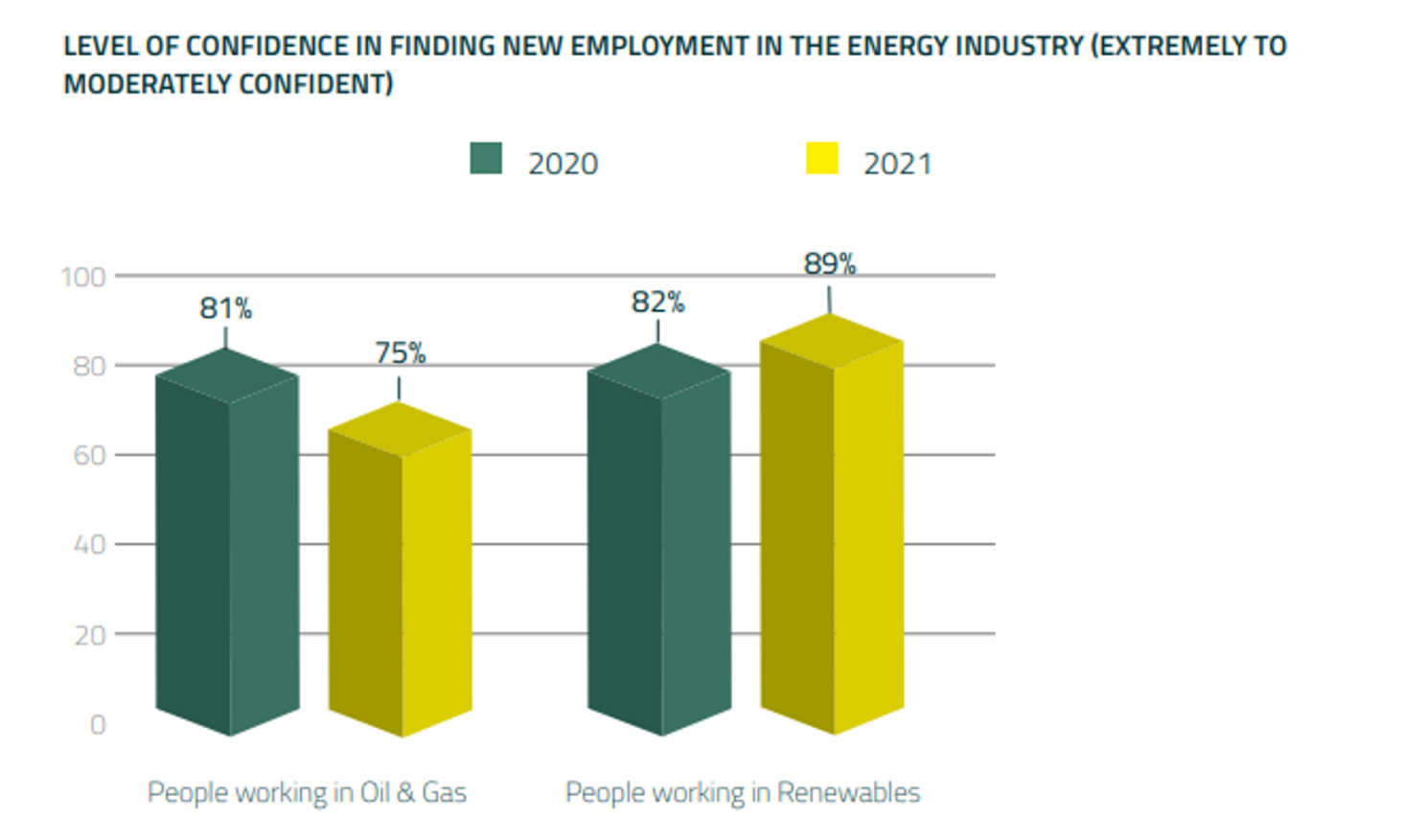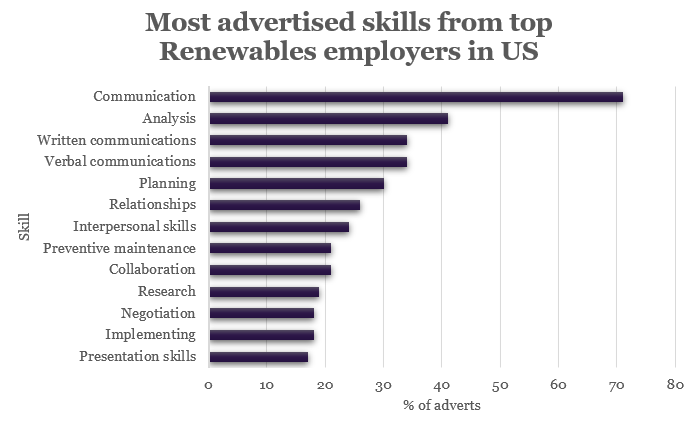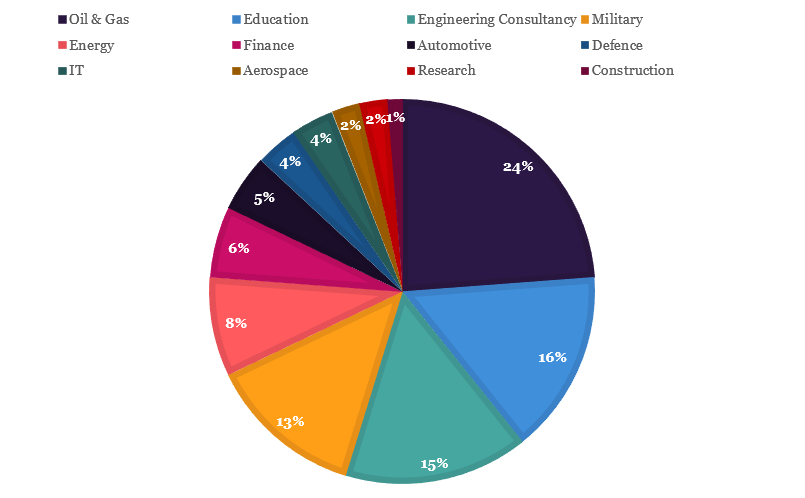Accelerating the energy transition – Recruiting for transferable skills

8 March 2022 — Climate change is with us and we all know that the energy transition from fossil fuels to renewables must be accelerated for us to ‘keep 1.5°C alive’. According to IRENA’s World Energy Transitions Outlook: 1.5°C Pathway, employment in the Renewable Energy sector will need to more than triple, from 12 million in 2020 to 38 million by 2030. These are astonishing and ambitious growth numbers and if they have any chance of being achieved, they will need to be supported by a whole host of strategies. These will include, transformational policy change, government funded training and investment schemes, strategic reskilling programmes and a change of mindset when it comes to recognising suitable talent for the sector.
In our series of blogs over the coming weeks we will be discussing some of these topics. For this blog we are going to focus on this ‘change of mindset’.
IRENA estimated that there were 12 million people employed in the Renewable Energy sector in 2020 which gives us a very strong indication of the size of the existing talent pool. There are also many people who categorise themselves as having skills in ‘renewables’, and while some of them are directly employed in the sector, many may not be. IRENA reports that there were 838,000 people employed in the US Renewable Energy sector in 2020, but according to our own research, carried out on SeekOut in December 2021, there were just short of 1.2 million people who categorise themselves as being skilled in renewables (nearly 45% more than are actually employed in the sector). Meanwhile, across the pond in the UK, IRENA said that 138,000 people are employed in the sector but again, according to SeekOut, those who categorise themselves as skilled in renewables could be as many as 365,000 (more than 2.5 times the number of people employed in the sector). These numbers are very encouraging, reflecting the potential transferable skills that are available in the market. However, even if all of the self-assessment of skills is accurate, and all of these people want to be employed in the sector, we will still struggle to get near to the growth numbers required for the 1.5°C compatible global pathway to become a reality.
What role can Talent Acquisition play in the talent challenge?
If we simply recycle the existing pool of talent and supplement this with school and college-leavers we will be nowhere near to achieving the growth that the Renewable Energy sector needs. Barriers to entry exist for strategies such as transformational policy change and it will take time before significant funds are raised by government or the private sector for training and re-skilling programmes. We must respond to the challenge by changing the mindset of hiring managers in the sector so we can access talent that has transferable skills.
The nature of work in the Renewables sector offers plenty of opportunity for ‘transferability’ of skill and there are of course, transferable skills evident from oil and gas to renewables.
The 2021 UK Offshore Energy Workforce Transferability Review from the RGU Energy Transition Institute found that 70% of the UK oil and gas workforce have medium skills transferability to other energy industries, principally onshore wind, and another 20% have high transferability.
This is particularly evident in the off-shore wind sector as high levels of transferability exist in manufacturing, planning, maintenance and operations – all aligned to some of the major challenges associated with large engineering projects in deep sea environments. While it is less of a challenge convincing hiring managers that they should consider these candidates, there is still hesitation. There needs to be a compelling reason why someone should leave the Oil and Gas sector and join the Renewables sector. Growing concern in the Oil and Gas sector around future career prospects provided by OGJS (illustrated below) supports this, but remuneration and reward need to be comparable. It is the job of talent acquisition professionals to explain these nuances to hiring managers and provide them with the insights to build business cases for offers they are making.

Source: OGJS
IRENA’s Renewable Energy and Jobs Annual Review 2021 shows that around half of all jobs in the sector only require minimal formal training and a non-degree level education, meaning that they are very accessible. This means that people with practical problem-solving skills and a good level of manual dexterity should be deemed as having highly transferable skills, and this talent pool could be available from a variety of industry sectors. Moreover, if we assume that between 10 and 15% of all roles within Renewable Energy companies will sit in corporate and administrative functions (20/22% according to The US Department of Energy) there is much more likelihood that this proportion of roles can be filled with people who have no previous experience of the sector (with the possible exception of highly specialist regulatory or legal roles). Once again, it falls on the talent acquisition teams to influence the beliefs and pre-conceived notions of hiring managers that for these corporate and administrative roles, Renewable Energy experience is not a ‘must-have’ requirement.
What are the skills most in demand in Renewable Energy?
Our own research on skills in the Renewable Energy sector carried out via SeekOut and TalentNeuron to establish trends in talent requirements and candidate profiles shows interesting results.
At 28.6%, ‘Project Management’ is the skill mentioned most often in professional profiles of candidates working in the UK Renewables sector. ‘Management’ is listed third at 27.8%. These two skills are universal and not specific to the Renewables sector. Other skills making up the top 10 include ‘Engineering’, ‘Project Planning’, ‘Business Development’, ‘Business Strategy’ and ‘Customer Service’. All of these skills are attributed via self-assessments and not necessarily listed as requirements by decision makers in the hiring process. However, if talent acquisition teams were able to highlight trends of this nature they could open up new pools of candidates outside of the sector.
The top five skills featured in the job adverts posted by the top US Renewables employers (January 2021 to January 2022) were Communication 71% (of all adverts), Analysis (41%), Written Communications (34%), Verbal Communications (34%) & Planning (30%).

Data: TalentNeuron
Finding candidates who are already applying these skills in a Renewable Energy setting would naturally be ideal, but at what cost? In future blogs we will investigate the reward element within Renewables to understand the extent to which companies competing for the same pool of talent is inflating salary levels in the industry. If hiring teams can be more creative, sourcing candidates with the above skills, the reward levels may be subject to less inflationary pressure. The Renewables sector also has an opportunity to attract a far more diverse range of people than what we see in the likes of Oil & Gas. Understanding the core skills required will allow the sector to be more accessible and be supported by a diversity of thought that is potentially lacking in other energy sectors.
Where can we find these skills?
Five of the top Renewables employers in the US are already looking for ways to identify sources of talent outside the existing Renewables marketplace. Having experience in the Renewables sector, although valuable, is secondary to identifying candidates with the relevant skills and competencies.
Our own research on which industries candidates worked in prior to joining the Renewables sector in the US, UK, Denmark, Norway and Sweden revealed, fairly unsurprisingly, that the Oil & Gas sector featured at the top of the list. There are several reasons for this; candidates may have worked offshore, in safety critical environments, in energy and in many cases worked for a company transitioning from Oil & Gas to one that provides an energy mix. In these cases candidates are able to move internally and are likely to adapt more quickly as they already understand company processes, values, systems, communications styles and may have established relationships with colleagues. However, The Society for Human Resource Management’s report ‘Preparing for an Aging Workforce, shows that approximately one-quarter of the current energy sector workforce is over 55 years-old and within 7 years’ time will retire. The Oil and Gas talent well will eventually run dry.
Second on the list of potential sources for Renewables sector candidates are those coming straight from education, followed closely by those from engineering consultancies. Candidates from engineering consultancies are often already embedded within client organisations so can transfer into renewables with relative ease.
Notably, other sectors that feature high on the list are, the Military, Finance, Automotive, Defence and IT.

Data: SeekOut
As per the above chart, industries that in part require candidates with good technical competencies are good sources for transferable skills. This is demonstrated when, using research from the AMS Insights team, we analyse the fastest growing role requirements in the Renewables sector (taken from job adverts in US).
Over the course of the last 12 months, the required skill, ‘Technical Direction’ has increased by 1592%. ‘Statistical analysis’ has gone up by 677% and ‘Analytics’ by 510%. On the flip side, the requirement for ‘Renewable energy technologies’ knowledge dropped by 21% and ‘Renewable energy industry’ dropped by 4%. The biggest increases were seen in ‘Electric grid’ (1729%) and ‘Electric power systems’ (1637%).
This demonstrates that US companies are aware of the challenges in attracting existing renewables experience and are already searching for the relevant skills, over sector experience. There are of course some roles which will require specific experience but if companies can hone in on the most crucial, core skills and identify where those skills exist in other sectors they will open up new talent pools, and open the doors of the Renewables sector to the next generation of the Renewables workforce.
This focus on recruiting transferable skills is just one strategy which the industry can take to meet the predicted demand for jobs in the Renewable Energy sector. In our futher blogs in this series we will also talk about reward schemes, DEI opportunites and early careers strategies and how these can help boost talent acquisition activites for the sector.
If you would like to talk to us about recruiting for the Energy sector then please do get in touch.
Authored by:

Lynne Gardner
Sector Managing Director

David Ingleson
Client Operations Director
More articles
AMS Announces Strategic Partnership with Clinch to Enhance Talent Acquisition Solutions
AMS announces a strategic partnership with Clinch to enhance talent acquisition with innovative recruitment marketing technology.
What’s the difference between recruiting and RPO?
RPO vs. staffing agencies: Discover the strategic, scalable recruitment solution that aligns with your long-term goals.
AI Readiness for Digital Transformation in the Industrial and Engineering Industry
Is your organization ready to harness AI for digital transformation? Explore how AI readiness can boost efficiency and innovation in the industrial and engineering sectors.

Start your journey to True Workforce Dexterity.
Discover how we can help you build, re-shape and optimise your workforce.
Talk to us






